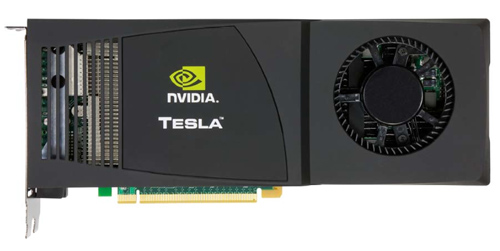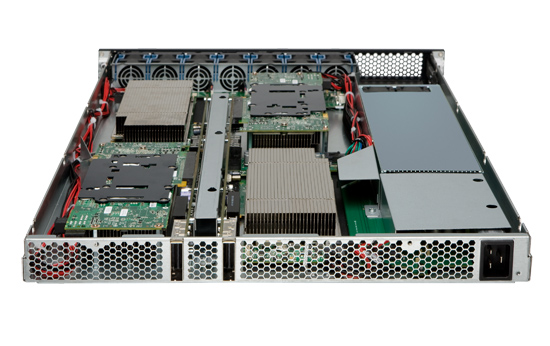NVIDIA's Fermi: Architected for Tesla, 3 Billion Transistors in 2010
by Anand Lal Shimpi on September 30, 2009 12:00 AM EST- Posted in
- GPUs
A Different Sort of Launch
Fermi will support DirectX 11 and NVIDIA believes it'll be faster than the Radeon HD 5870 in 3D games. With 3 billion transistors, it had better be. But that's the extent of what NVIDIA is willing to talk about with regards to Fermi as a gaming GPU. Sorry folks, today's launch is targeted entirely at Tesla.

A GeForce GTX 280 with 4GB of memory is the foundation for the Tesla C1060 cards
Tesla is NVIDIA's High Performance Computing (HPC) business. NVIDIA takes its consumer GPUs, equips them with a ton of memory, and sells them in personal or datacenter supercomputers called Tesla supercomputers or computing clusters. If you have an application that can run well on a GPU, the upside is tremendous.

Four of those C1060 cards in a 1U chassis make the Tesla S1070. PCIe connects the S1070 to the host server.
NVIDIA loves to cite examples of where algorithms ported to GPUs work so much better than CPUs. One such example is a seismic processing application that HESS found ran very well on NVIDIA GPUs. It migrated a cluster of 2000 servers to 32 Tesla S1070s, bringing total costs down from $8M to $400K, and total power from 1200kW down to 45kW.
| HESS Seismic Processing Example | Tesla | CPU |
| Performance | 1 | 1 |
| # of Machines | 32 Tesla S1070s | 2000 x86 servers |
| Total Cost | ~$400K | ~$8M |
| Total Power | 45kW | 1200kW |
Obviously this doesn't include the servers needed to drive the Teslas, but presumably that's not a significant cost. Either way the potential is there, it's just a matter of how many similar applications exist in the world.
According to NVIDIA, there are many more cases like this in the market. The table below shows what NVIDIA believes is the total available market in the next 18 months for these various HPC segments:
| Processor | Seismic | Supercomputing | Universities | Defence | Finance |
| GPU TAM | $300M | $200M | $150M | $250M | $230M |
These figures were calculated by looking at the algorithms used in each segment, the number of Hess-like Tesla installations that can be done, and the current budget for non-GPU based computing in those markets. If NVIDIA met its goals here, the Tesla business could be bigger than the GeForce one. There's just one problem:
As you'll soon see, many of the architectural features of Fermi are targeted specifically for Tesla markets. The same could be said about GT200, albeit to a lesser degree. Yet Tesla accounted for less than 1.3% of NVIDIA's total revenue last quarter.
Given these numbers it looks like NVIDIA is building GPUs for a world that doesn't exist. NVIDIA doesn't agree.
The Evolution of GPU Computing
When matched with the right algorithms and programming efforts, GPU computing can provide some real speedups. Much of Fermi's architecture is designed to improve performance in these HPC and other GPU compute applications.
Ever since G80, NVIDIA has been on this path to bring GPU computing to reality. I rarely get the opportunity to get a non-marketing answer out of NVIDIA, but in talking to Jonah Alben (VP of GPU Engineering) I had an unusually frank discussion.
From the outside, G80 looks to be a GPU architected for compute. Internally, NVIDIA viewed it as an opportunistic way to enable more general purpose computing on its GPUs. The transition to a unified shader architecture gave NVIDIA the chance to, relatively easily, turn G80 into more than just a GPU. NVIDIA viewed GPU computing as a future strength for the company, so G80 led a dual life. Awesome graphics chip by day, the foundation for CUDA by night.
Remember that G80 was hashed out back in 2002 - 2003. NVIDIA had some ideas of where it wanted to take GPU computing, but it wasn't until G80 hit that customers started providing feedback that ultimately shaped the way GT200 and Fermi turned out.
One key example was support for double precision floating point. The feature wasn't added until GT200 and even then, it was only added based on computing customer feedback from G80. Fermi kicks double precision performance up another notch as it now executes FP64 ops at half of its FP32 rate (more on this later).
While G80 and GT200 were still primarily graphics chips, NVIDIA views Fermi as a processor that makes compute just as serious as graphics. NVIDIA believes it's on a different course, at least for the short term, than AMD. And you'll see this in many of the architectural features of Fermi.










415 Comments
View All Comments
Voo - Saturday, October 3, 2009 - link
You may overseen it, but there was a edit by an administrator to one of his posts which did exactly what you want ;)james jwb - Sunday, October 4, 2009 - link
that's good to hear :)Hxx - Friday, October 2, 2009 - link
By the looks of it, Nvidia doesn't have much going on for this year. If they loose the DX11 boat against ATI then I will pity their stockholders. About the only thing that makes those green cards attractive is their Physics spiel. Now if ATI would hurry up and do somethin with that Havoc, then dark days will await Nvidia. One way or the other, its a win-win for the consumer. I just wish their AMD division would fare just as well against intel.Zool - Friday, October 2, 2009 - link
I dont wont to be too pesimistic but availability in Q1 2010 is lame late. Windows 7 will come out soon so people will surely want to upgrade to dx11 till christmas. Also OEM market which is actualy the most profitable. Dell, HP and others will hawe windows 7 systems and they will of course need dx11 cards till christmas.(amd will hawe hopefully all models out till that time)Than of course dx11 games that will come out in future can be optimized for radeon 5K now while for gt300 we dont even know the graphic specs and the only working silicon dont even resemble to a card.
Very bad timing for nvidia this time that will give amd a huge advantage.
Zool - Friday, October 2, 2009 - link
Actualy this could hapen if u merge a super gpgpu tesla card and a GPU and want to sell it as one("because designing GPUs this big is "fucking hard"). Average people (maybe 95% of all) dont even know what Megabyte or bit is not even GPGPU. They will want to buy a graphic card not cuda card.If amd and microsoft will make heawy DX11 pr than even the rest of nvidias gpus wont sell.
PorscheRacer - Friday, October 2, 2009 - link
As with anything hardware, you need the killer software to have consumers want it. DX11 is out now, so we have Windows 7 (which most people are taking a liking to, even gamers) and you have a few upcoming games that people look to be interested in. For GPGPU and all that, well... What do we have as a seriously awesome application that consumers want and feel they need to go out and buy a GPU for? Some do that for F@H and the like, and a few for transcoding video, but what else is there? Until we see that, it's going to be ahrd to convince consumers to buy that GPU. As it is, most feel IGP is good enough for them...PorscheRacer - Friday, October 2, 2009 - link
Actually, thinking about this... Maybe if they were able to put a small portion of this into IGP, and include some good software with it, maybe the average consumer could see the benefits easier and quicker and be inclined to go for that step up to a dedicated GPU?RXR - Friday, October 2, 2009 - link
DocSilicon, you are one funny as hell mental patient to be!. I really hope you dont get banned. You just made reading the comments a whole lot more fun. Plus, it's win win. You get to satisfy your need to go completely postal at everyone, and we get a funny sideshow.- Friday, October 2, 2009 - link
Great words but nothing behind! Fermis is Nvidias Prescott or should I say much like the last Voodoo chip that never really appeared on the market? Too many transistors are not good ...ioannis - Friday, October 2, 2009 - link
Although the Star Trek TNG reference is ok, 'Nexus' should have been accompanied by a Blade Runner reference instead, Nexus-6 :)